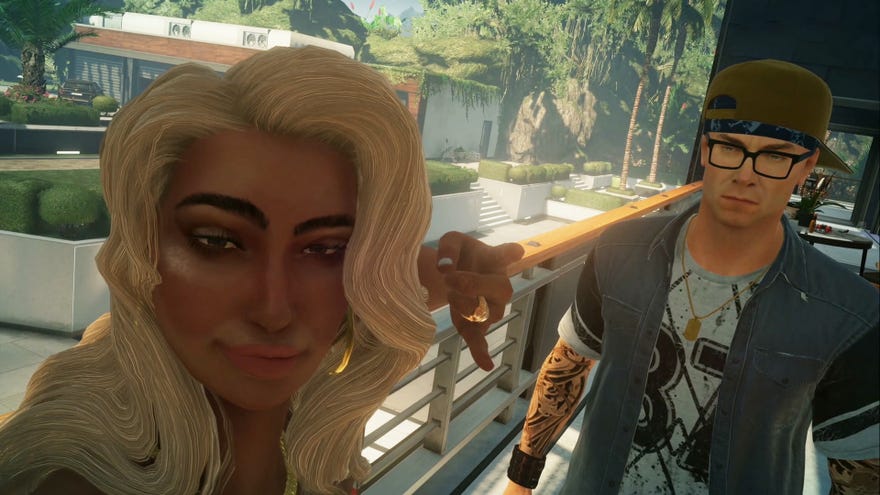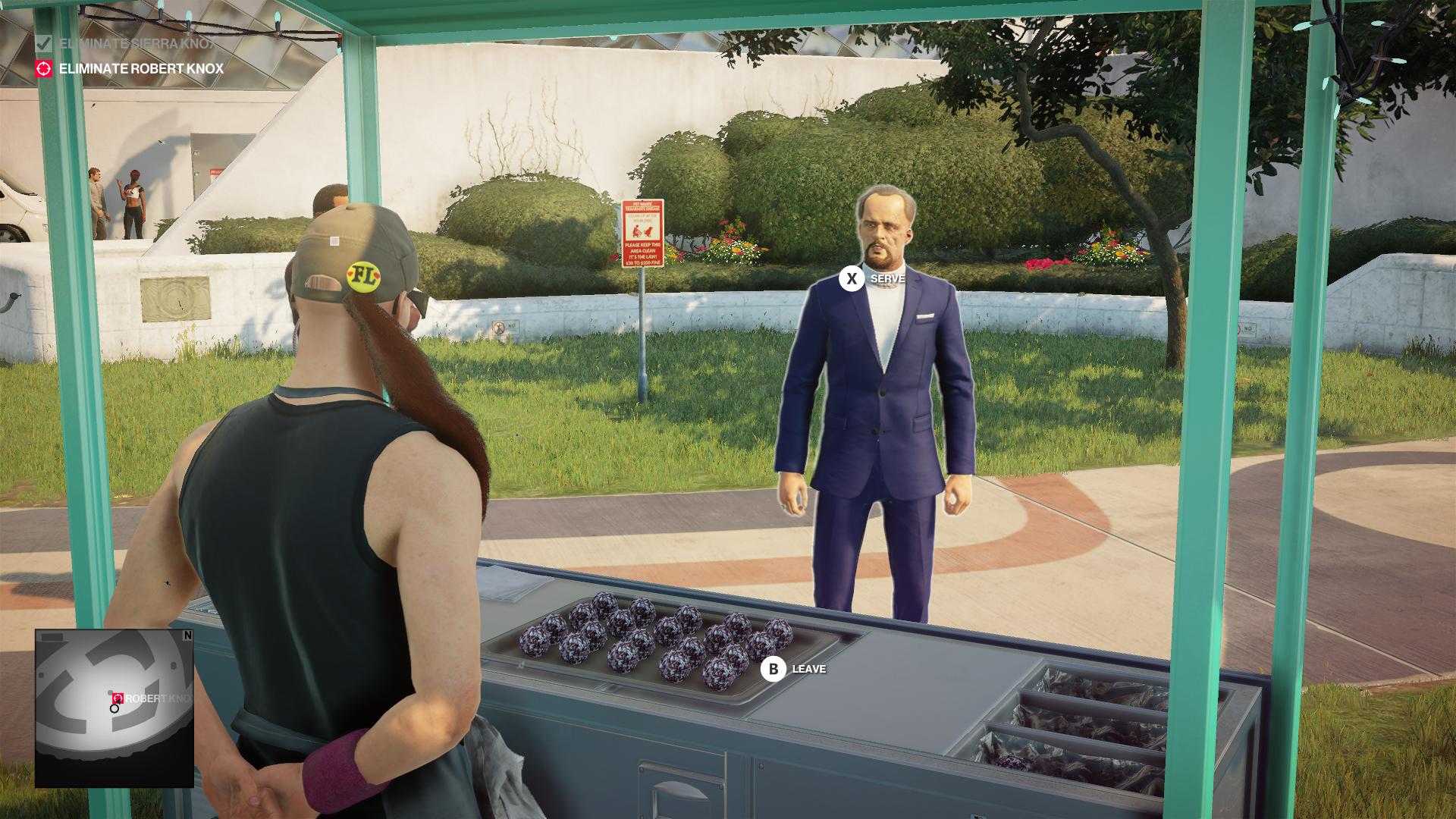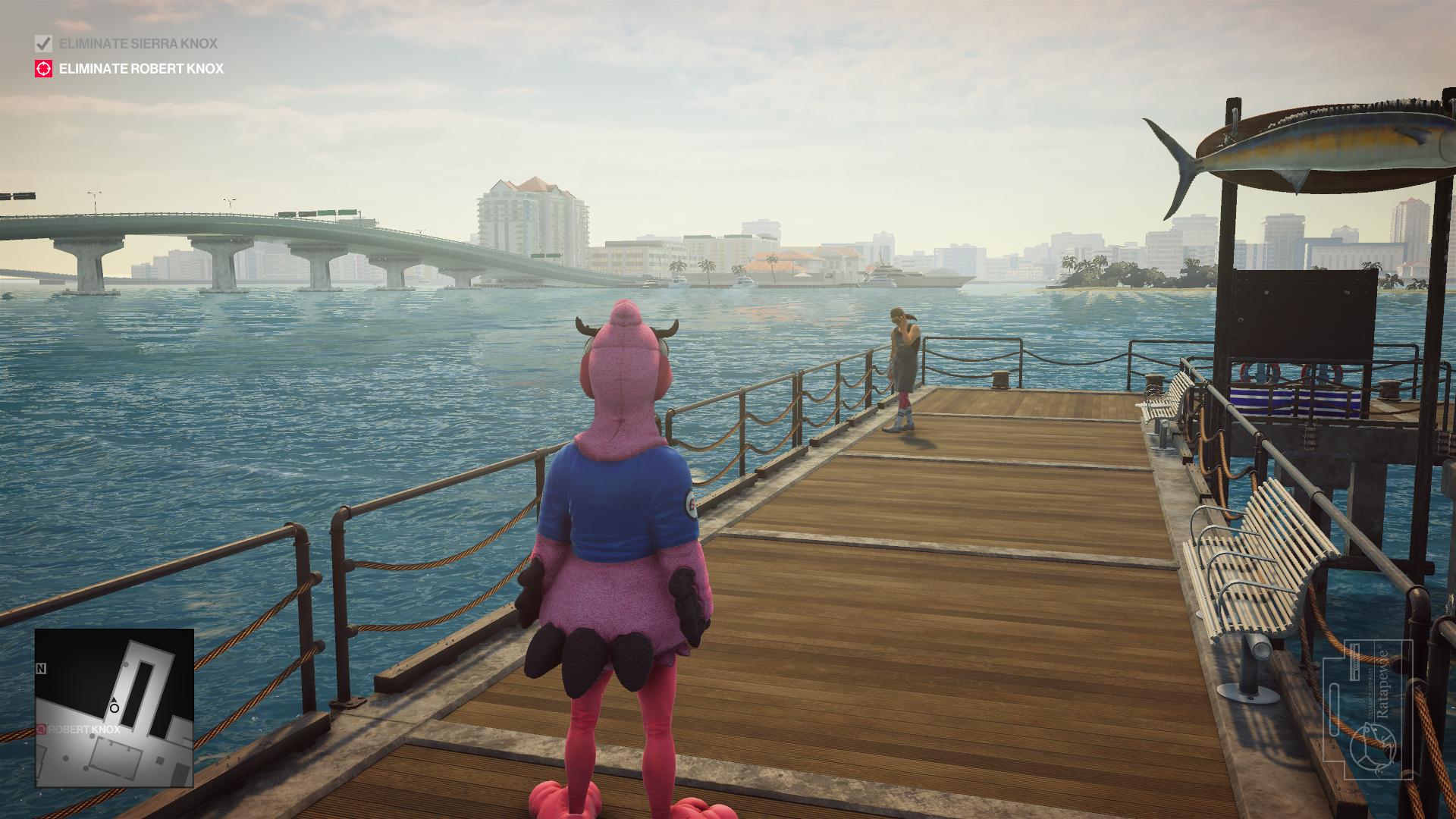Hitman's humour evolved because of 47's penchant for disguises
Shoot the real me!
In the best possible way, the Hitman series is ridiculous. Its protagonist, Agent 47, is the single most conspicuous person in any crowd. He’s big and bald and white with a bar code prominently tattooed to the back of his head, and not once does this fact deter him from his preferred method of infiltration: wearing a disguise.
These aren’t disguises in the elaborate, Mission: Impossible, we’ll give you an entire fake head sense. No, 47 simply throws on the clothes of whatever guard or unfortunate bystander he’s subdued. And this actually works. In the franchise’s fiction, he’s considered one of the most dangerous people in the entire world, the best of the best. This imposing figure who scarcely bothers to alter his body language, let alone his voice, is a master of disguise. Like its 2016 predecessor, Hitman 2 is quite aware that this concept is absolute nonsense.
Its every level provides 47 with the goofiest disguises and outlandish “accidents” for assassinating his targets. Sometimes he even make ominous little puns while going about his business — “It’s to die for,” he says, as he hands out a poisoned food sample. Comedy fits these games as well as everyone’s clothes inexplicably fit Agent 47, which makes it easy to forget that such full-throated self-awareness wasn't always a mainstay for the series. For its first few games, Hitman used to be kind of a bummer.
The business of hitting men is a grim business indeed, and the series used to reflect that by wallowing in lurid spectacle. The first proper level in 2004’s Hitman: Contracts, the third game in the series, has 47 infiltrate some kind of sinister sex rave within a meat-packing plant. Blood flecks the walls, animal carcasses fill the corners, and, in one gore-covered room upstairs, the corpse of a girl hangs upside down before a makeshift shrine, where the word “BITCH” is scrawled on one of her pictures. Pine air fresheners hang with her to cover the stench, and 47 must retrieve her severed arm as proof of the murder. There’s no humour here, just a skeevy darkness that makes the whole thing an unpleasant sit, to say the least. In another level you poison a whole stable of horses.
That Hitman used to pair such material with its goofball disguise system sounds absurd, but back then it didn’t stand out as quite so goofy. The series is nearly two decades old, and firing up the first game, Hitman: Codename 47, is more than enough proof that the year 2000 was quite a long time ago. The levels seem more rudimentary compared to now, with samey NPCs and only a handful of outfits -- a far cry from the dazzling detail of Hitman 2016’s Sapienza or Hitman 2’s Colombia.
Watching a rather blocky Agent 47 pop on someone else’s clothing and plausibly fool certain characters doesn’t at all look out-of-place within the technical limitations of the time. But in much the same way as adding tangible hair and realistic eyes to a Pokémon creates an ungodly abomination, injecting realism to the exploits of Mr. 47 alters the effect. His presto chango routine and ability to remain incognito begin to seem alien and unconvincing when you can easily tell character models apart.
It’s no surprise, really, that the franchise began to play the incongruity for laughs. It's the fourth game, Hitman: Blood Money, that seemed to first recognise that 47’s sinister occupation and the years of gritty baggage that come with it make the character perfect for deadpan contrast. It provided everyone’s favourite assassin with outfits like a clown suit or a giant bird costume. He is the po-faced professional that never questions what the job requires, even if it requires, say, putting on a big red nose. But as much as Blood Money marked an eye for comedy and a slight lightening of tone, it was still largely a straight-faced game (and one that trafficked in some horrendous racial stereotypes as early as the tutorial level).
At this point, 47 wasn’t the one that needed to change so much as the mean-spirited world around him. 2012’s Hitman: Absolution was an awkward stepping stone to what the franchise would eventually become. It added more comedy than ever, more convoluted assassinations and more bizarre disguises (the chipmunk mascot costume is a highlight). But it also attempted to reconcile the inherent silliness of Agent 47 by adopting a stylised, in-your-face tone reminiscent of exploitation films, most infamously in its extermination squad of nuns with a rubber fetish. Though more self-aware than the series had ever been, Absolution’s misjudged aesthetic plunged the series once again into the sort of grime seen in Contracts.
The modern Hitman games have gone in a different direction. They still play their stories straight, but you get the sense that they do so not just for consistency’s sake, but to deliberately contrast the total embrace of absurdity in the levels themselves. 47 can strut across a catwalk, disguised as a model called Helmut Kruger. He can perfectly play the drums while dressed, stone-faced, in flamboyant rocker garb. And the world around him finally seems in on the joke, as characters tend to nudge the fourth wall or make outrageous comments rather than react like normal people.
Much of the comedy is predicated on the way we expect these games to function, the way they have functioned in the past. When 47 disturbs a level’s clockwork routine, the generic cries for help or the questions of “What’s going on?” are still there, but now have a layer of absurdity smeared on top. When a character goes for help, they might cry out the
hilariously nonspecific, “Somebody’s doing stuff they shouldn’t!” Act strangely and bystanders tell 47 to act his age — “How old are you?” they ask. “46, 48?”
Ambient conversations are peppered with lines meant to get you to turn your head, as a guard insists he can develop gills if he learns to hold his breath long enough, and one disgruntled scientist argues over the phone with HR about bodyguards monopolising the soda machine. One outfit gets 47 mistaken for the rapper Pitbull. Hitman’s world of assassination still hides a dark underbelly, but it’s a far brighter, sillier place that offers a welcome evolution from the atmosphere of cruelty that once choked the series. Everyone’s simply a little bit dopey and unaware. Sometimes it all begins to feel like slapstick — one of the early melee weapons you can unlock in Hitman 2’s Miami is a large fish.
With the focus on comedy, 47 is able to become pretty much the worst assassin of all time whilst still being technically successful, as he hides and puts on disguises that no one can honestly believe should work. The nearly twenty-year-old mechanics of the Hitman series as something approaching social commentary. In Hitman 2’s Colombia, 47 can disguise himself as a celebrity tattoo artist named P-Power, the host of a reality TV show who’s in the area to touch up a drug lord’s neck tattoo. Despite there being no resemblance whatsoever between the two, once 47 dons P-Power’s glasses and turns his hat around, no one questions him until he meets the drug lord himself. “Look at those cheekbones,” the drug lord says, as he insists 47 looks nothing like P-Power does on TV. The drug lord’s wife, a huge fan who even takes a selfie with 47-as-P-Power, dismisses the concerns as a trick of the camera. She’s the one who wants the tattoo fixed in the first place, the one who needs 47 to actually be P-Power.
Other people in Hitman 2 can also see through 47’s disguises. As in the previous game, characters with white dots above their head are capable of blowing 47’s cover if they get a long enough look at him. His handler Diana warns that certain guards in the Mumbai level are specifically on the lookout for assassins, and they’re capable of picking out 47 no matter what he’s wearing. It all suggests that 47 actually isn't hidden very well, and that people are too self-absorbed to pay enough attention.
As the boldness of 47’s methods has skyrocketed, his visibility to the public has bottomed out. He is, by and large, exploiting the obliviousness of the world around him; he plays on unthinking deference to a man in the right outfit standing more or less where he’s meant to be standing. He can even cross racial lines and don the outfits of an Indian tailor or a Colombian drummer. It only follows that no one in this ignorant, self-absorbed interpretation of the world can see colour.
“People do tend to see uniforms and not faces,” Diana proclaims in the tutorial level, yet the disguises reach such blatantly ridiculous heights that the rationale has to extend further: people see only what they want to see. And what people least want to see — the wealthy, corrupt targets of 47 least of all — is an instrument of vengeance being wielded against them as tangible proof that their actions have consequences. The franchise’s greatest joke is that, in leaning into comedy and away from oppressive darkness, Hitman 2 has honed 47’s fundamental absurdity into some truly wicked satire.












